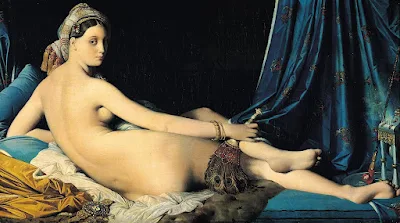
(Ingres, Jean-Auguste-Dominique. The Grand Odalisque.
c. 1814. oil on canvas. Louvre, Paris.)
Returning to Paris from Rome in the 1820s, Ingres became embroiled in aesthetic controversy. With his emphasis on draftsmanship and classical values, he was revered as the leading exponent of academic art, in contrast to the wilder approach of the Romantics headed by Delacroix. Ingres took an approach to idealize nude subjects in which the line of the subject took precedence over color and the figure resembles a living statue.

(Ingres, Jean-Auguste-Dominique. Napoleon, I Crowned.
c. 1806. oil on canvas. Musee de Armee, Paris.)
Throughout his career, Ingres sought to create the perfect, classical nude. The Valpincon Bather, named after an early owner, was painted while he was in Rome and is one of Ingres’ most classical works. The subject dons a pose that Ingres used again and again and is sometimes placed in a harem in the works he painted later on.

(Ingres, Jean-Auguste-Dominique. The Bather of Valpincon.
c. 1808. oil on canvas. Louvre, Paris.)
The subject has exotic potential and the sunken pool hints that this is a bathhouse. The mood is cool and remote. The softly curving outlines of the figure contrast with the vertical folds of cloth. Critics often complained that Ingres’ nudes seemed boneless, noting here that the bather appears to have no ankles.

(Ingres, Jean-Auguste-Dominique. Oedipus and the Sphinx.
c. 1808. oil on canvas. Louvre, Paris.)
As part of the Neo-Classical movement, Ingres had a preference for highly finished paintings. He said that paint should be as smooth “like the skin of an onion” which was certainly a classical trait, but some of his exotic subjects bordered on the side of the Romantic movement. His female nudes are both elegant and graceful, his work is much appreciated here!
Enjoy :)
Reference: King, R. Art. New York: DK Publishing, 2008.